#6: Archeological Site, Delphi (general report)
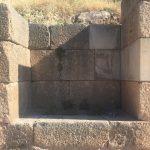
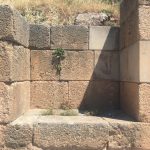
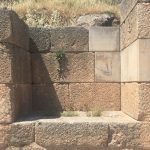
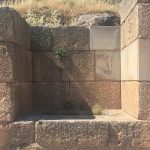
We all met the day before at the busstation in Athens. Together we travelled to Delphi.
On arrival we agreed to meet next morning at opening time at the Archeological museum.
On Saturday May 28 at 08.00 we came together at the entrance of the museum.
We bought tickets for the museum and the archeological site, we had a coffee and I explained to the others the character and the background of TheParallelShow. We discussed the experimental nature of the project and the possibility to change any rule (except the rule of leaving no traces).
We then all individually left for the Sanctuary to explore the site and to find possibilities and opportunities.
At the start we were tourists as well as participants in the project, and susceptible to the history and beauty of the site. It takes some time to get accustomed in order to distance oneself somewhat from that first impression.
At 12.00 we met again at the entrance and, as a group, returned to the town to have lunch and to discuss the possibilities.
After lunch, back at the site, we started to carry out two cooperative works (concepts of Ellen and Maarten) and then the team split up to perform all individual works.
Finally we met again at the entrance of the museum at 18.00.
#5: Let’s meet every now and then
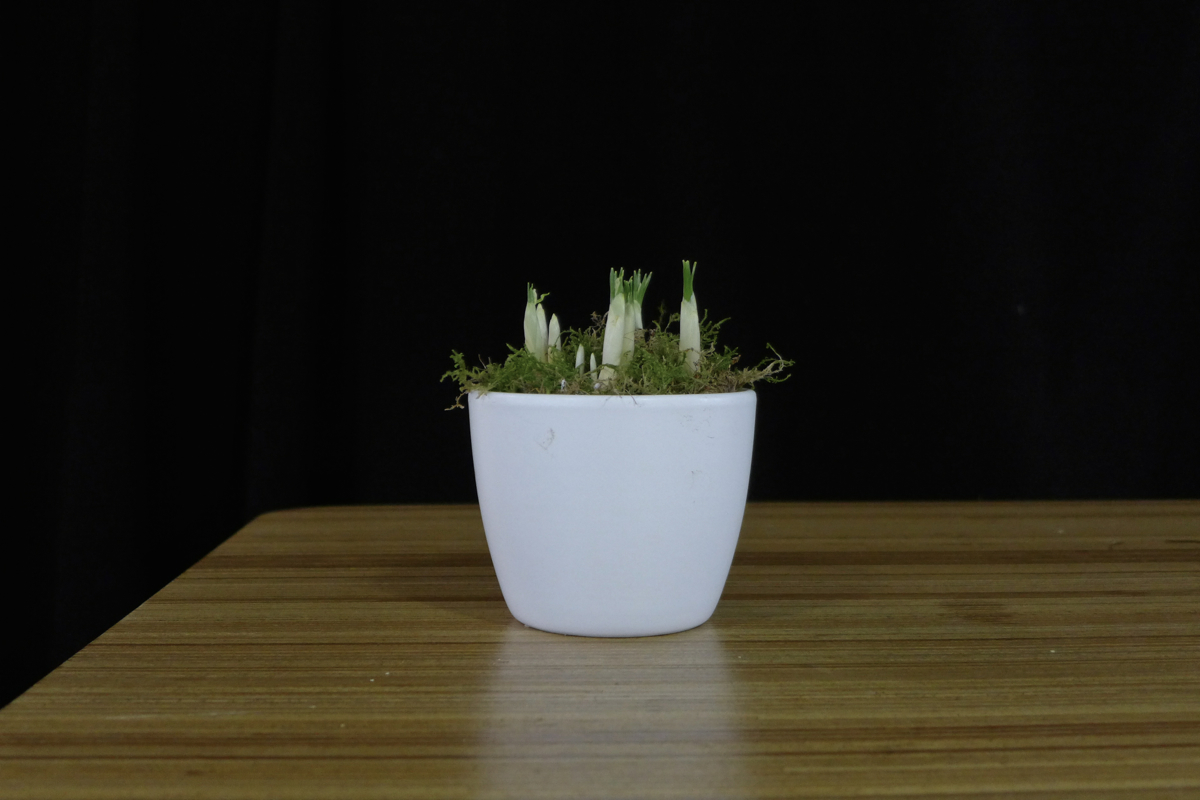
After walking around at Art Rotterdam for about one and a half hour in the Van Nelle Factory I find myself somewhere in the back of the Fair wondering what I am doing there.
A woman is talking on her phone: “Where are you? I can’t find you..” she says. This is a very fundamental comment on what is going on. Everybody seems to be moving between getting lost and being found.
There is a kind of pattern in which people seem to move around at the fair. As if everyone is part of a secret community, moving at a certain pace, bumping into one and other and then getting out of sight again.
This observation became the starting point of my performance proposal
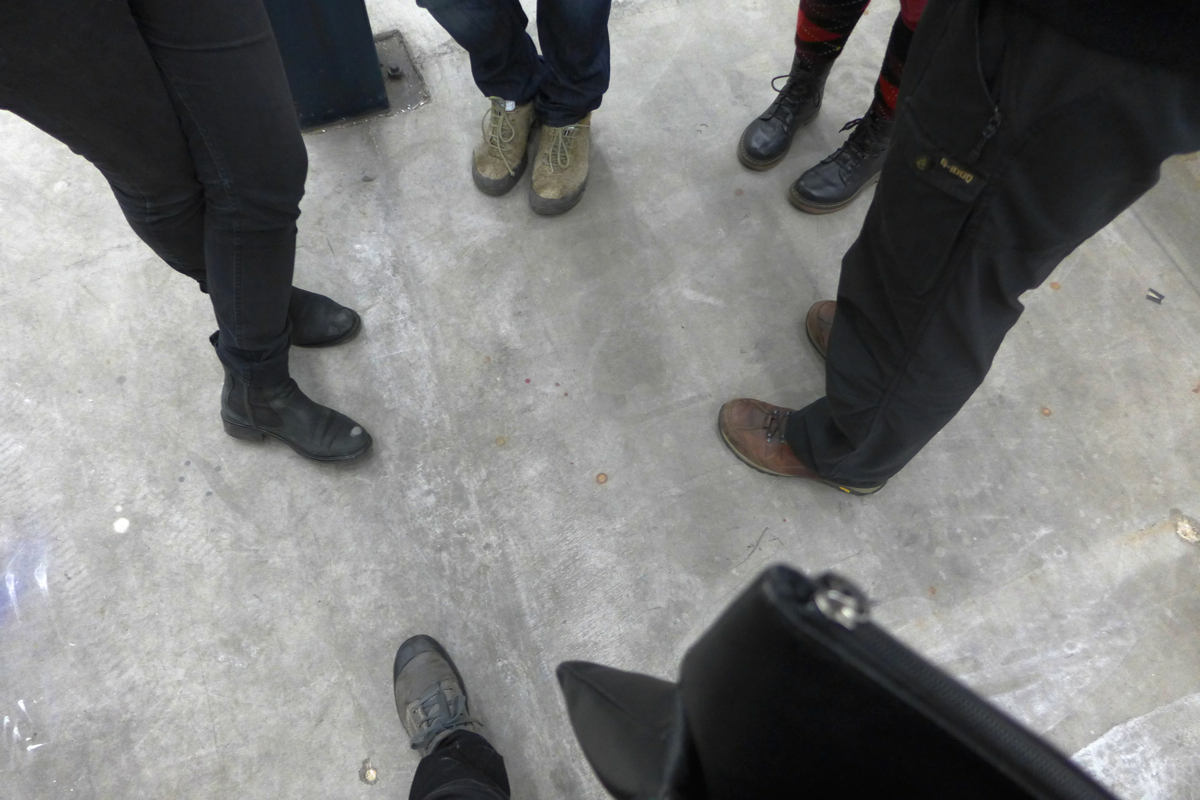
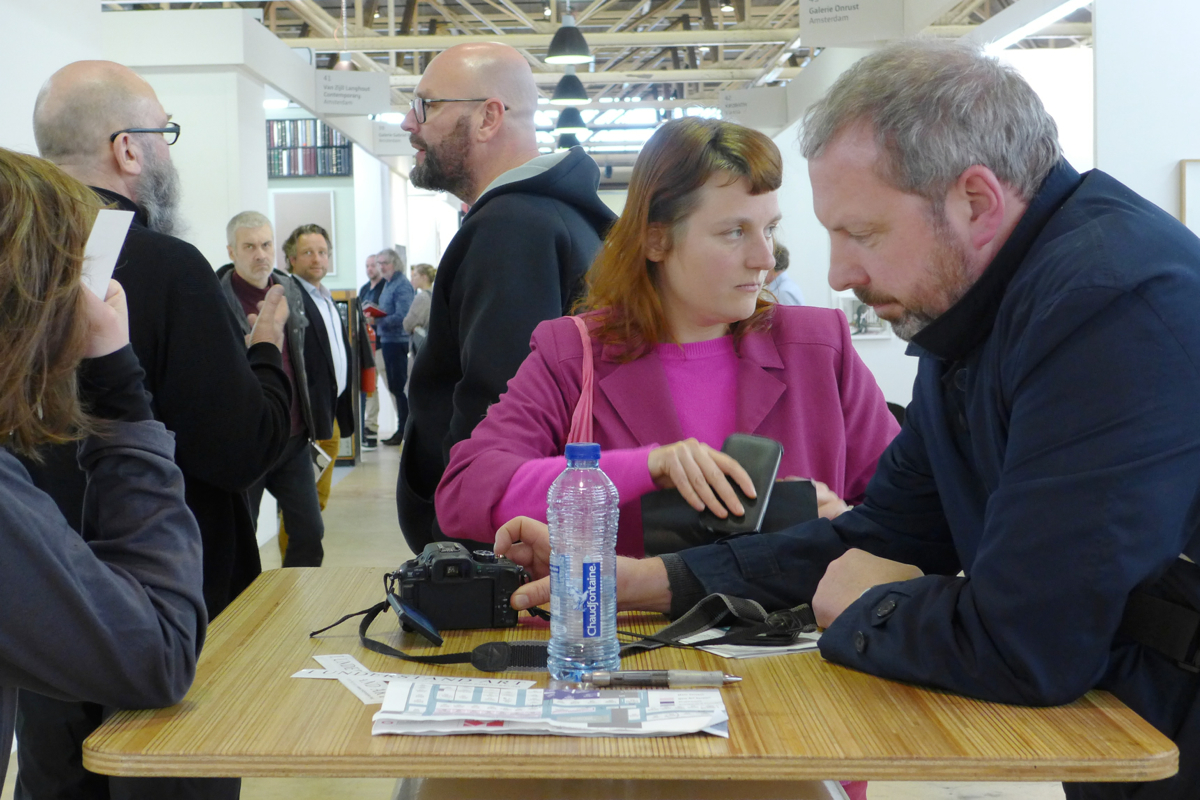
“Let’s meet every now and then”.
We agreed upon meeting each other all together every now and then at the tables that were placed in the corridors between the gallery-spaces. And so we did, in between other performances.
This was somehow confusing; it might have worked out in a more powerful way if we would have been more equally focused on the concept.
It was interesting though as a choreographed way of moving separately together, like one breathing body getting lost and being found again.
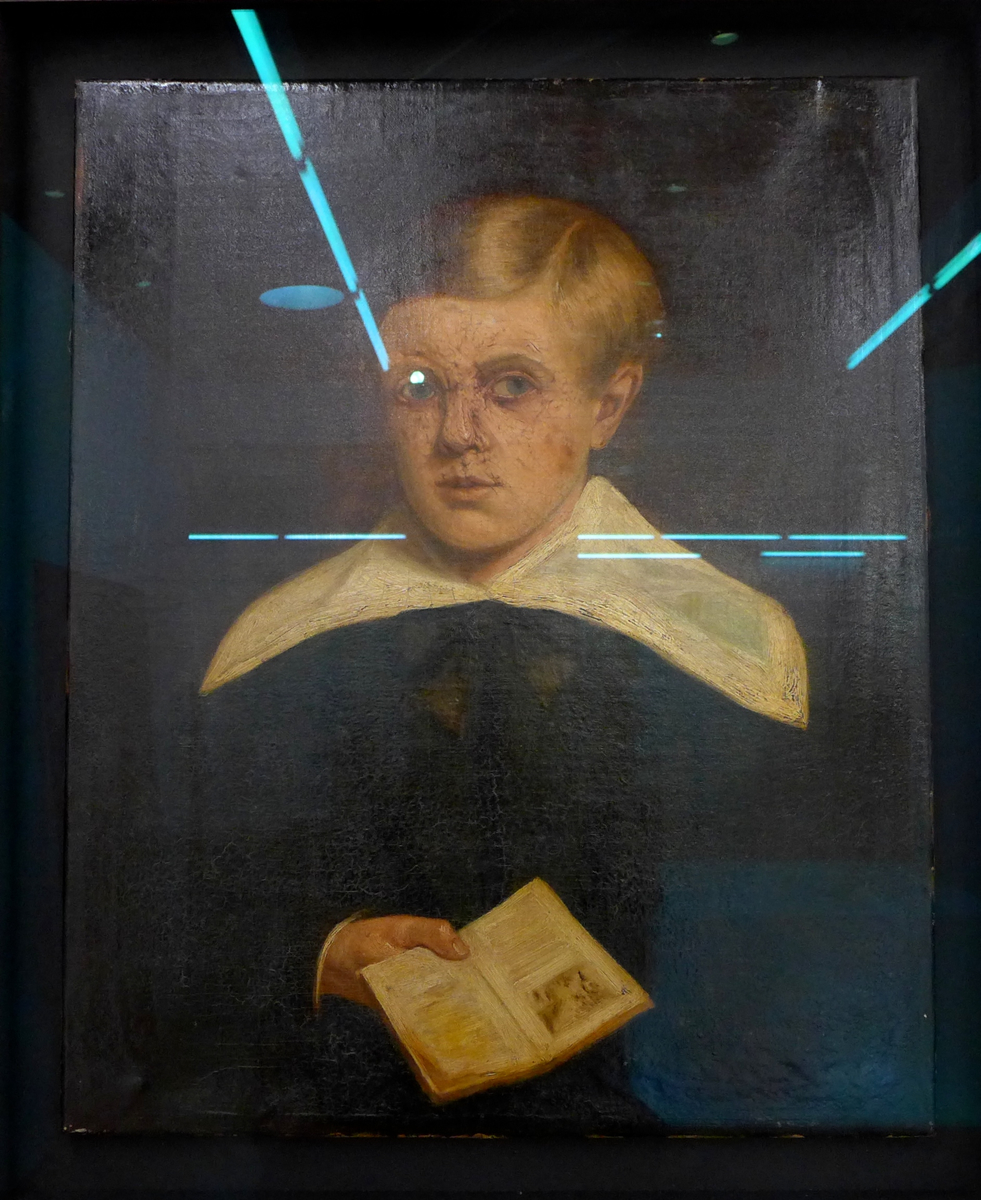
Looking at a work of art intensely for 15 minutes.
Ieke Trinks proposed to watch a work of art for 15 minutes.
I found myself in front of a portrait of a young man, that seemed to be from the 19th century. It was by Jake and Dinos Chapman. The more I watched the more I felt uncomfortable.
There seemed to be some kind of evil hidden in the representation of this young man. I took a picture. My presence remained unnoticed or at least uncommented by the gallerist. I was glad to leave the painting behind.
Photo’s: © IK
#5:
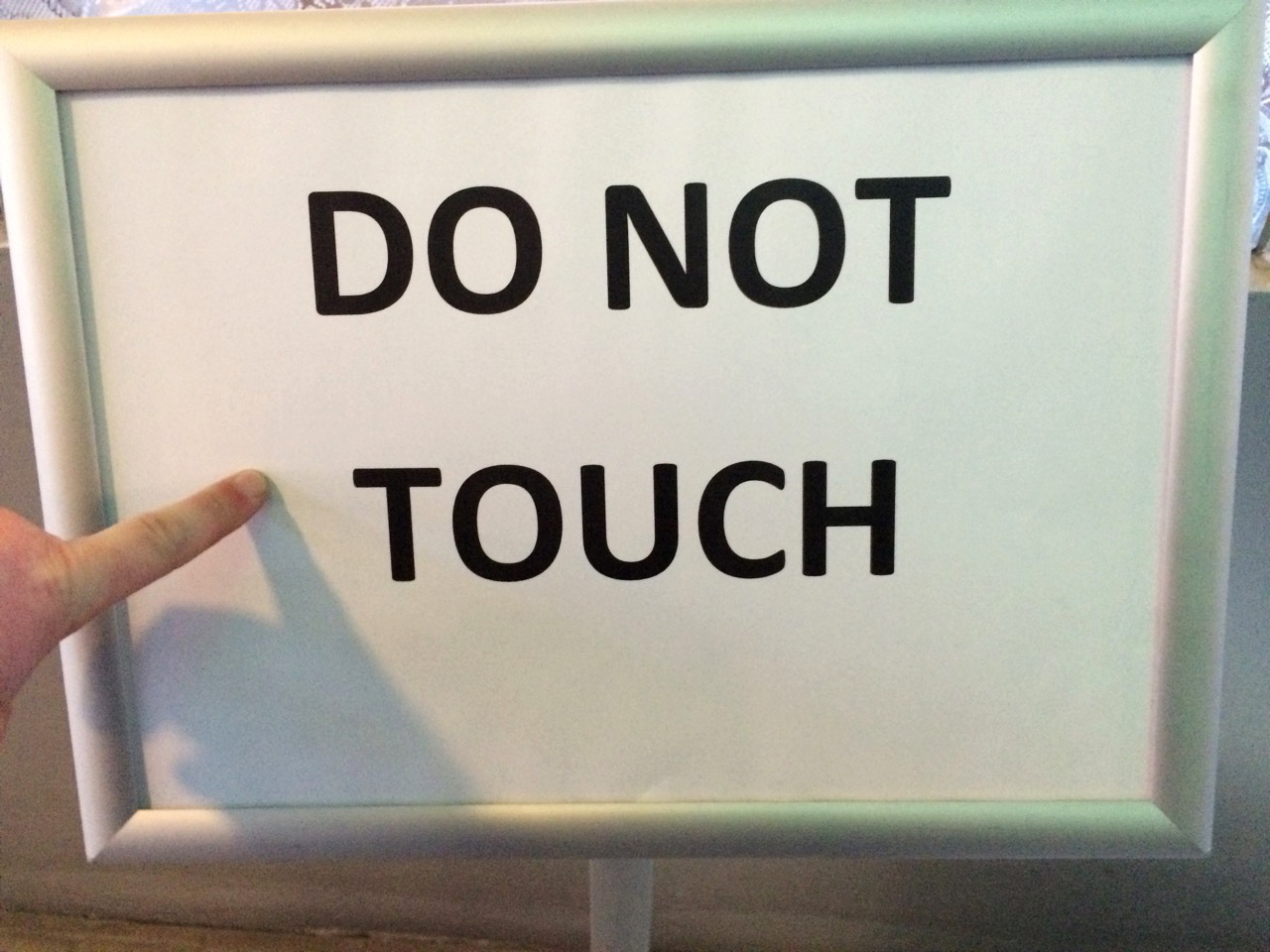
It is first important to consider the context of both the site and those occupying the site: the professional market-oriented art world.
The overall site had a strong sense of the proprietorial – a context distinct from that of a public museum, or even a commercial gallery. Booths represented temporary fiefdoms and a considerable investment for galleries, so space oscillated uncomfortably between public and private. Make yourself at home, but not too much. Move along if you’re not buying… There is no sense of the ideas of self-improvement or didacticism of the museum. Ideas are discussed, but only as commodities, or exotica, to enhance the allure of the objects. Artists are often treated in the manner of farm animals: useful for their products but better kept securely in a field, remotely. One of the dangers of the site is the instinct to engage in pranks.
The social relations, protocols and signals present at this kind of event are important. Presentation or staging is a major factor in the processes at play and the self-staging of the art world has its own tropes – work is given space to allow it to look proper, but not too much. It’s expensive space, so the balance is crucial and carefully established. Curators/gallerists, dress conservatively, but with a twist, as if to reaffirm or proclaim a subtext, variously: counter-cultural; whacky; super rich; aesthete. If they are male, they wear expensive suits or jackets, but with trainers (expensive). The women wear dresses generally, and accessorise with exotic spectacles, or hairstyles: asymmetric; dyed; gamin. And they all smell expensive.
I wore expensive scent (Tom Ford, Grey Vetiver) as I circulated. It was, perhaps, too subtle.
Prescribed Disruption/Variable Reception (2016)
We undertook a variation on this work – available at: theconceptbank.org – which involves disrupting usual patterns of looking at art. In this case we used audioguides: Ieke and Ienke acted as ‘mules’, carrying the hidden audioguide, circulating the booths. (I had audioguides from the Modernamuseet in Stockholm on my iPhone, the ‘mule’ carried a bluetooth speaker in their bag. If they stopped by a work, I activated an audioguide.) We used guides for works by Lucio Fontana, Marcel Duchamp and Joseph Kosuth. In most cases this improving contextualising was ignored, or treated with mild curiosity. One gallerist engaged in a jovial, but passive aggressive manner, the quicker to be rid of us, it felt.
Looking at a work for 15 minutes.
This was very demanding. I chose a small work by Julie Cockburn, a found image augmented by hand embroidery. It was at the rear of a space. As it was glazed it reflected to me what was happening behind me as I looked at the work. I was aware of a kind of low level anxiety amongst the gallery staff (there were two) caused by my presence, and over the period the booth emptied – it had been busy when I entered – perhaps why I chose this – and empty by the end as though my extended presence, a transgression of, or challenge to the accepted protocols of looking at art in a social context, had spooked new viewers. I chose to engage with the gallerists after the 15 minutes, I think to dispel any concerns or instabilities my presence might have generated. Or to legitimate my actions. Always polite…
In addition to the above, I also met someone I knew.
Photo: © AM
#5: Static Painting
Choose one artwork and spend 15 minutes looking at it. Before all 5 of us start executing this idea, each one points out on the art fair’s map the gallery where one will go to watch an artwork.
My decision was arbitrary. I didn’t know the gallery, and I can’t remember from my earlier visit what kind of art is present there. When I walk into the gallery’s stand I don’t take the time to look around but go straight to the first work hanging on a wall. It’s near the gallerist table. As soon I stand still in front of the work I set the timer for 15 minutes.
I start looking at the artwork. What do I see? It takes a while to get my concentration into the activity of seeing. I’m distracted by the thought that I’m going to stand here for 15 minutes and that I might get noticed. An art fair is not a museum. In a museum one can spend time in front of a work without being noticed too much. Here it is unusual. My presence could be understood to be a provocative gesture. Could I be recognized as an art collector or a curator? If not, what could be my interest in spending such an amount of time this way?
I redirect my focus back on the artwork. Then the doubt comes in. Was this a good choice? Wouldn’t I rather spend time on a different artwork? Will this become a rewarding experience? Is it about having a rewarding experience? What does rewarding here mean? Is it rewarding if I discover something that I wouldn’t have known if instead I had taken a quick look at it?
I tell myself that time is the important factor, no matter what I’m looking at. There is always an opportunity to discover a deeper meaning or something unexpected to discover, as long one takes time for something. I am looking at a canvas hanging in a standing position with blue and pink paint. The blue is the first layer covering the whole canvas. The pink’s arbitrary brushstrokes are the second layer. When I take a closer look the pink strokes are vertical and seem to be carelessly placed. Here and there they overlap one another. I get the impression that the painting doesn’t want to be something other than paint on a canvas. I try to think figurative. I see a sky at sunset and pink clouds. I can’t stay long with this in my imagination. The painting doesn’t want me to make it into something other than a canvas with blue and pink paint.
What do I know of painting in general? Maybe I haven’t enough knowledge to read such a work. It worries me. I go for a different strategy. What do the colors mean to me? The pink reminds me of my early teenage period, where I was allowed to paint my own bedroom. I was warned to use subtle colors. The pink in my room was an ugly color, just like this pink. But the blue in the canvas is worse. Baby blue. I fail in my attempt to appreciate the work. It might be because I don’t know a few things: the title, whether it is part of a series, and who the artist is.
What was the artist’s intention? What if the painting is a detail of something bigger? What if the pink brushstrokes are an imitation of the artist’s studio wall? What if the painting is of a painting in its early moments of creation, when it is first being set up? Maybe I’m going too much into conceptual thinking. Why can’t it be a work that allows for brushstrokes intuitively placed? The painter taking pleasure in the action of painting.
I feel a sudden shock going through my body. For a moment I think I hear the gallerist’s voice addressing me, but it is to someone else. I wouldn’t know what to say to the gallerist but I am curious what she would say about this work. My attention is drawn to my body now. I suddenly think I’m too motionless and start shuffling my feet, change the position of my arms and move my head unnecessarily, as if I am actively browsing the painting. The alarm goes off. I turn around to see if the gallerist looks in my direction. Nothing happens, she talks with someone. Dazed I leave the stand.
#5: Talks and Calls
An art fair is about art but it is even more about competition, shortlists and commercial value.
It is a spectacle, loud, chaotic, overwhelming. Within these dynamics it is difficult to focus.
I decided to aim mainly at the social activities around the art.
Calls
In my pocket i carried a business model telephone. I asked my colleagues to call me on that phone as often as possible during the day. When they called me I never answered, I never got the phone out of my pocket. It just rang on till it automatically switched to voicemail.
I assumed the sound radiated a message of personal importance on one hand, and of arrogant indifference on the other: I clearly looked like a person people wanted to speak to and I chose to ignore the calls because I had ‘other things’ on my mind.
I hoped this made me more a player than an art lover.

Talks
The second work was connected to the first. as said I decided not to focus on the presented artworks, but to focus on people in and around the gallery booths. So I looked for acquaintances, for people I met before.
Whenever I recognised somebody and it was possible to approach the person, I started a short talk. Often it was just chitchat but sometimes it developed into an interesting conversation.
As soon as my colleagues noticed me speaking with somebody, they turned into an audience and were consciously observing the dialogue.
Looking at a work for 15 minutes
Ieke Trinks asked each of us to choose one specific work of art and to observe that for (at least)15 minutes. I chose the work Kalochrome by Michael Portnoy. In this work Portnoy uses image-steganography, a method for hiding (other) images within the encryption of the image.
Such a long-time observation fitted this work perfectly. This way it might be possible for me to enter its hidden layers.
So I stood there for fifteen minutes, studying the image. Slowly its surface changed, from just the depiction of a green kale into an abstract digital grid. There it stopped, nothing more was revealed.
The long time gaze took away the spatial illusion of the photo and in return it gave a clear focus on its actual material surface.
Some time ago I had this same experience in my performative work Polder.
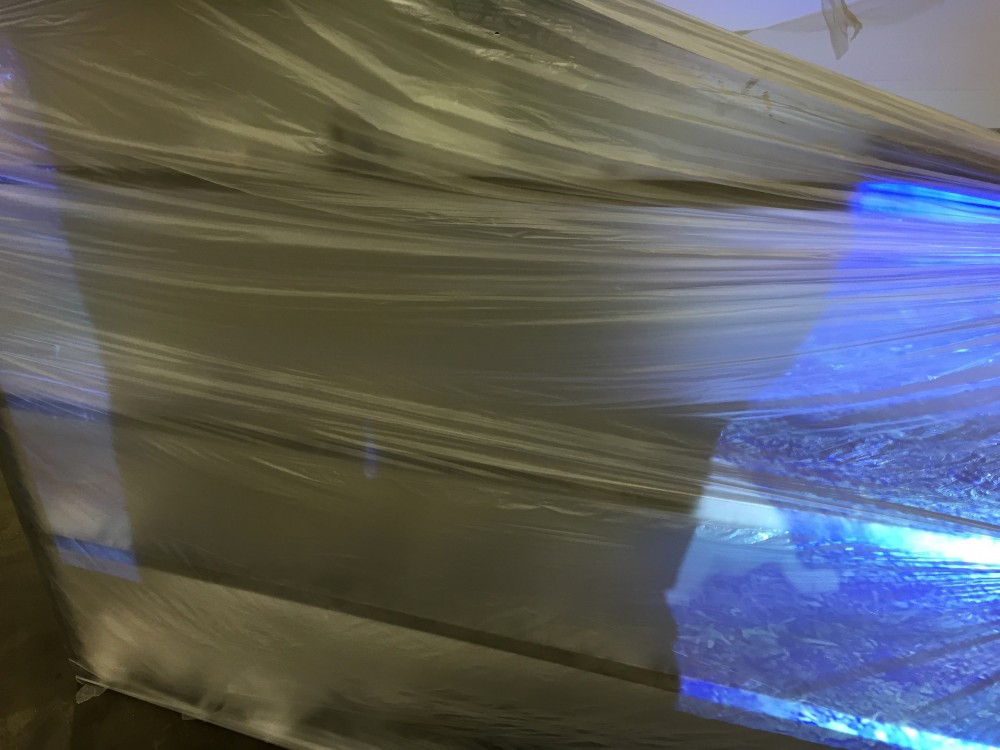
A new layer
Daniela Degen asked us to put ‘a new layer’ on a presented artwork, a gesture to influence its appearance, to change its aura. In an installation I stood between the beamer and the object it projected on. By blocking part of the beamed image I brought back the material qualities of the plastic projection surface. For a short time it regained some of its sculptural qualities.
Photos: © IK, ©FvL
#5: Adding and Applying
Adding another layer
Adding another layer means interfering with an artwork in order to change viewing perspectives. I asked myself how I can deconstruct a reserved, distant view on a work of art. Depending on the chosen work, you would come up with different approaches, reactions.
To uncover the technical side of an uncommon video format i moved the mouse left on a beamer to make cursor and video player visible.
To question the environment in which artworks are shown i blew heavily against a painting where feathers were affixed to.
To show the side effects of a video installation i used the beamer aeration as an electric fire, a handwarmer.
Applying red dot stickers
In the art world the red dot indicates that an artwork has been sold, while leaving it on view for the rest of the exhibition. In order to annulate one main purpose of the art fair, i applied red stickers on various labels to take the artworks of the market on the first day of the show. Questions that evolved after this intervention: Can that change an artistic career? A shy admirer not being able to buy a piece. A collectors glimpse dismissing a position due to misleading signs. How much do we believe in those signs? How quick do we loose or how superficial is a consumer interest? What are the leading viewing structures of an art fair and how do they affect our way of looking at things?
#5: Art Rotterdam (general report)
We met on February 11 at 11.00 in front of the main entrance of the Art Rotterdam Art Fair.
We entered the restaurant together for a cup of coffee and to discuss our approach to the event.
A year ago we already planned The Parallel Show at the Art Rotterdam Art Fair 2015.
Ieke Trinks, Ienke Kastelein, Peter Baren and I discussed the concept during a meeting in my studio some weeks before. At that time there was no intention of making it the start of a series, it was conceived as a unique occasion.
Because of personal circumstances this ParallelShow was finally cancelled. Some months later, in July 2015, it still took place at the Kunsthal in Rotterdam (#1).
Because of our positive experiences at this first occasion it became the start of a series of ParallelShows.
For that original Parallel Show in the art fair of 2015 we had a clear idea how to approach. We would all design a personal concept for one chosen gallery booth. In this gallery booth we would perform this work (without invitation or anouncement) in front of the group, as a practical instruction to all participants. After that we would all carry out each others works successively in the chosen gallery booths, thus creating a repetitive line of performances.
Of course this original concept was discussed again in this new occasion. The group was slightly different now. Peter was not joining us and Andrew and Daniela were now part of it.
Not all of us were convinced about the original framework so we first visited the shows individually before we decided how to proceed. We would meet again for lunch at 01.30.
At the lunch meeting, we concluded not to use the original framework. We all had our own clear ideas on what to do. We discussed the plans and decided what to perform, individually and together, and in what order. After lunch we returned to the show together.
Finally it turned out to be a mix of solo works and groupworks in a somewhat chaotic improvised setting, probably the clearest representation of the dynamics of this type of art show.
#4: Learning in Public
The starting point for my research in Tate Britain was Drawing for Free Thinking a wall mural around the Manton staircase. The work by David Tremlett explores the floor plans and architectural features of Tate Britain through abstraction, and was of particular interest to me as it was made by the artist and a group of assistants by massaging pastel crayon directly onto walls with the palms of their hands. Physical and material thinking – albeit confined within and to the geometries and formal lines of the building and architectural plans. Over the course of the day, I kept mistaking the title of the work as Diagram for Free Thinking. This appeared significant in that a diagram is the externalisation or making public of a thinking process, and seemed to be what was at stake for me in this day of research at Tate Britain.
The body does not always easily fit into geometric or chronologic shapes and ideas, but these can often be the things that inform and shape both movement and thinking. As navigation of the building was well defined and controlled, I sought alternative trajectories and less valued methods and agents towards freeing up my thinking. It was difficult to find spaces not specifically designated as public. Source materials to hand included overlooked spaces and details: corridors, storage rooms, a corner of a wall and the lip of a stair.
In line with my current research into listening as a practice and mode of performance, I decided to use ‘listening’ as a method. I followed a high pitched sound coming from the Turner Wing, and left the building and walked its perimeter. Returning inside, I visited Susan Philipsz’ installation War Damaged Musical Instruments in the Duveen Galleries. Although the sound installation permeated most of the building, I sourced materials to listen to in a more multi-modal way. Making physical contact with and also using my voice to explore imperfect architectural details – damaged surfaces, wall stains, broken skirting corners and cracks, I ‘listened to’ and followed these features as an attempt to experiment with an embodied thinking through the building. This was productive and related back to my current practice and recent work, but my unusual activities attracted attention from others also present in the building. My visible, and audible, research in the context of a sound installation within an art institution became recognisable as performance and gallery visitors became an audience.
I decided to try another a method, less recognisable as performance and one which might promote a more intimate proximity and relationship not only to the building, but to the activities of others using the building. Earlier that morning in passing, a friend had reminded me of Brian Eno’s Oblique Strategies. This work consists of a set of cards in which each card offers an aphorism intended to encourage lateral thinking. By way of coincidence, Andrew, over lunch, mentioned a website that listed daily oblique strategies. The strategy for today was “breathe more deeply”. This instruction connected back to a conversation that we had about a ten day silent meditation retreat that I had been on and to my research in and with groups. Over lunch we also discussed institutions such as Tate as public spaces for self-improvement. This was interesting to me in that as opposed to structured and formal learning, informal learning, attracting labels such as self-improvement or leisure, tends to imply a lack of seriousness, and is by implication often less valued. I decided to use my meditation practice, a practice commonly labeled as self-improvement and one not normally associated with thinking, to experiment with learning in public.
Not about breathing deeply, meditation involves breathing differently, paying attention to automatic and habitually unattended to processes. Practicing meditation publicly in an art institution, my intention was to sit and meditate not just with art works, but also with groups of people.
I installed myself as a type of live or performing sculpture in various rooms. I experimented with various positions and postures for mediation: for example, sitting on the floor next to a sculpture, standing in front of a painting, while also making bodily contact with a wall, a floor, or a corner. I experimented with opening and closing my eyes and how doing so might affect my practice. I paid particular attention to listening to the sounds around an artwork: for example, how the work responded to sounds refracting off its surfaces, or how my own internal dialogue affected both the art work and my breathing.
As a different strategy, I joined groups of people gathering in different configurations throughout the building. Some were groups of strangers sitting silently on couches in galleries and foyers, some contemplating works, others seemingly waiting. When someone spoke, I tried to follow the speed of their words and thoughts. The couches also had their own speeds, at times there was a restless influx of people and at other times the rate was singularly slower. The things that shape our thinking and the shape of our thinking.
#4: Dancing in Tate Britain
As a reaction to the rigid structure of the building, the subdued watching habits of the public and the tendency to expand my empire I decided to dance! We talked about the possibility to dance on the present sound, but in that way it rather seemed a performance than an intervention. For me the most interesting aspect was to create a parallel way of looking to the artworks.
I listened to music of the following artists: Andrew Bird, Madonna, The Gossip and LMFAO.
By wearing earplugs, I isolated myself from others and created a different space. I noticed this especially in the connection to the paintings. The figures were stripped from their importance, no kings, queens, counts and godesses no more. They became people to flirt with, to give comments on their (lack of) clothing, and to small talk with. They’d probably liked this different approach, at least I did.
The more contemporary pieces on the other hand gave me more space to dance. Their abstract features made it less narrative, so I started dancing exuberantly. PARTY!
Also the presence or lack of people had their share in my way of dancing. I noticed some people laughing at me or even filming my dancemoves. It felt a bit uncomfortable, but I decided to neglect them. It felt good nót to be unnoticed, but I decided that this shouldn’t influence my concentration. At one point, two young people started to kiss, at that moment I really felt the presence of a parallel party.
So I danced and danced and danced and danced.
SORRY FOR PARTYROCKING!!!!!
Video:© FvL
